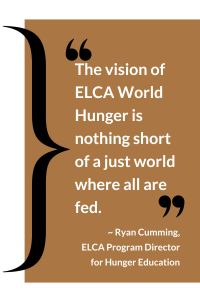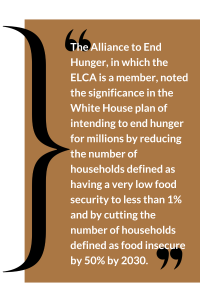When the ELCA signed a request of President Biden to host a White House Conference on Food, Nutrition, Hunger, and Health, the group of organizations stated: “We can end hunger in America, and a public commitment to a White House Conference, with ending hunger as a key priority, is an essential step in accomplishing this goal” (March 14, 2022 Letter). The conference sponsored by the White House on September 28 became the second of its kind in over half a century. Tackling hunger, nutrition and health in America was the theme, accompanied by the announced Biden-Harris Administration National Strategy on Hunger, Nutrition, and Health.
Hunger in the United States
 According to the White House data on hunger, nutrition and health, 1 in 10 American households experience food insecurity. Additionally, diet-related diseases are some of the leading causes of death in the United States of America: 10% of Americans have diabetes, 1 in 3 Americans will have cancer in their lifetime, and more than 40% of Americans suffer from high blood pressure. These grim statistics disproportionately affect communities of color, people living in rural areas, people living in U.S. territories, people with disabilities, older adults, LGBT community members, military families and veterans. It is with this landscape that the work being done by government programs such as Supplemental Nutrition Assistance Program (SNAP); Special Supplemental Nutrition Program for Women, Infants, and Children (WIC); school meals and Child Tax Credits (CTC) is important for meeting basic needs. Among ELCA federal policy prioritization is supporting the strength and reach of these programs.
According to the White House data on hunger, nutrition and health, 1 in 10 American households experience food insecurity. Additionally, diet-related diseases are some of the leading causes of death in the United States of America: 10% of Americans have diabetes, 1 in 3 Americans will have cancer in their lifetime, and more than 40% of Americans suffer from high blood pressure. These grim statistics disproportionately affect communities of color, people living in rural areas, people living in U.S. territories, people with disabilities, older adults, LGBT community members, military families and veterans. It is with this landscape that the work being done by government programs such as Supplemental Nutrition Assistance Program (SNAP); Special Supplemental Nutrition Program for Women, Infants, and Children (WIC); school meals and Child Tax Credits (CTC) is important for meeting basic needs. Among ELCA federal policy prioritization is supporting the strength and reach of these programs.
White House Conference and Strategy Highlights
Over 500 elected officials, advocates and activists, and leaders of business, faith and philanthropy groups from across the United States convened in Washington D.C. as well as virtually to discuss the Administration’s goal of “ending hunger and increasing healthy eating and physical activity in the U.S. by 2030.” The first step toward achieving this goal was announced by President Biden: the commitment of $8 billion by public and private sectors toward helping to provide more food and better nutrition by 2030.
It is through the release of the 44-page Biden-Harris Administration’s National Strategy on Hunger, Nutrition, and Health that the White House gave a direct and detailed plan. This strategy calls for a “whole-of-government” approach that is pursued across five pillars.
 Improve food access and affordability – approach includes goals to increase access to free and nourishing school meals, provision of Summer Electronic Benefits Transfer (EBT) benefits to more children, and expansion Supplemental Nutrition Assistance Program (SNAP) eligibility to more underserved populations. This pillar in the strategy names helping all Americans become economically secure as a critical step to reduce hunger and associated disparities toward “making it easier for everyone—including individuals in urban, suburban, rural, and Tribal communities, and territories—to access and afford food.”
Improve food access and affordability – approach includes goals to increase access to free and nourishing school meals, provision of Summer Electronic Benefits Transfer (EBT) benefits to more children, and expansion Supplemental Nutrition Assistance Program (SNAP) eligibility to more underserved populations. This pillar in the strategy names helping all Americans become economically secure as a critical step to reduce hunger and associated disparities toward “making it easier for everyone—including individuals in urban, suburban, rural, and Tribal communities, and territories—to access and afford food.”- Integrate nutrition and health – approach includes pilot coverage of medically tailored meals in Medicare, testing Medicaid coverage of nutrition education, and expanding Medicaid and Medicare beneficiaries’ access to nutrition and obesity counseling.
- Empower all consumers to make and have access to healthy choices – approach proposes a front-of-package labeling scheme for food packages, an update the nutrition criteria for the “healthy” claim on food packages, expansion of incentives for fruits and vegetables in SNAP, and facilitation of sodium reduction in the food supply by issuing longer-term, voluntary sodium targets for industry.
- Support physical activity for all – approach includes expanding the U.S. Department of Health and Human Services’ Centers for Disease Control and Prevention’s (CDC) State Physical Activity and Nutrition Program to all states and territories, investing in efforts to connect people to parks and other outdoor spaces, and funding regular updates to and promotion of the Physical Activity Guidelines for Americans.
- Enhance nutrition and food security research – approach includes bolstering funding to improve metrics, data collection and research to inform nutrition and food security policy, particularly on issues of equity and access; and implementing a vision for advancing nutrition science.
This Strategy and Our Convictions
 Non-governmental programs were highlighted by President Biden during the conference, and he expressed that “everyone has an important role to play”. This includes private and non-profit efforts, to which ELCA congregations, social ministries and ELCA World Hunger initiatives are deeply committed.
Non-governmental programs were highlighted by President Biden during the conference, and he expressed that “everyone has an important role to play”. This includes private and non-profit efforts, to which ELCA congregations, social ministries and ELCA World Hunger initiatives are deeply committed.
The Alliance to End Hunger, in which the ELCA is a member, noted the significance in the White House plan of intending to end hunger for millions by reducing the number of households defined as having a very low food security to less than 1% and by cutting the number of households defined as food insecure by 50% by 2030. “The White House laudably built its strategy based on feedback from stakeholders, the general public and those with lived experience of poverty and hunger… We now look forward to working with our diverse network to determine the action steps that will bring the plan to fruition.”
“The vision of ELCA World Hunger is nothing short of a just world where all are fed,” says Ryan Cumming, ELCA Program Director for Hunger Education. “Congregations, social ministries and local partners have a key role to play in this work. They are on the frontlines of responding to hunger and connecting neighbors to public support, but just as importantly, they are building the relationships rooted in justice, love and hope that will be needed to end hunger for good, together. The White House’s national strategy is a key step to that future.”
Recordings of panel sessions and plenary sessions are available online.
